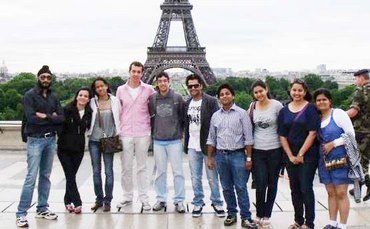 | « Back to article | Print this article |
Here's how you can walk, shop and save energy!
Meet Shubhi Gupta and Prateek Goel, two passionate students who proved their mettle in a college competition when pitted against 25 finalists from around the world!
Fast Facts
Competition: Go Green in the City challenge by Schneider Electric, a global specialist in energy management
Winners: Suma Elengikal and Maria Lafuente, University of Bonn, Germany
Runners up: Prateek Goel and Shubhi Gupta, MDI Gurgaon (in the picture) in a tie with IIM-A
Background: Both are engineers with work ex at Nestle and Microsoft (respectively)
Invention: Green Walks Slippers, which convert mechanical energy into electrical energy
The competition
The "Go Green in the City challenge" is creative case competition launched by Schneider Electric in eight countries across the world.
The competition tests the creativity of the students by analysing their solutions to environmental and logistical issues.
The two-member team had one women member compulsory to ensure equal participation for girls.
Students had to come up with viable solutions for energy management within five sectors critical to the city: home, university, retail, water and hospital. 25 best teams were selected and flown to Paris for the finals on June 23-24, 2011.
The big idea
Both the MDI students have a keen interest in mechanics and wanted to come up with a viable, affordable and implementable energy solution to contribute an environment friendly device.
Their model was how slippers worn by shoppers and employees can produce electrical energy for the retail stores and produce energy simply by walking.
The students conducted a research on the people visiting the malls and the retailers to gauge their reaction about the slippers and the response was highly encouraging.
They thus embarked upon their ambitious project to bring about a change. Many people had tried to develop such a slipper as they felt that the model seemed obvious but had failed.
Thus the students learnt from the mistakes of others, conducted a research, and worked diligently to develop their model.
Their hard work and efforts finally bore fruit when their model was appreciated and liked by the jury members as well as the people at Schneider Electric.
The appreciation and adulation for the model gave a delightful feeling of having achieved something according to Prateek.
How the contest unfolded
It was through a mail from the student committee that Prateek and Shubhi came to know about this contest. The contest was divided into three stages. Stage I was open to all.
A one-minute video explaining the concept of your model had to be submitted in this round. 100 teams were short listed from around 500-600 entries which were received in this round. In the next stage students had to further explain their concept, its working and its environmental impact in a document of about 800 words.
The top 25 teams from this round were short listed and flown to Paris for the finals.
During the high-octane event, the finalists presented their green solutions aiming to improve energy management in a city to a jury comprising higher- level executives from Schneider Electric.
The MDI team used a clever strategy and wore T-shirts of Green Walks for the finals designed by them.
The two days in Paris were a phenomenal experience according to Prateek. It gave them the opportunity to make friends from different cultures as well as have a learning of a lifetime.
The finalists were offered a guided tour of Paris. Schneider Electric organised workshops, field activities, lectures, interviews and case studies.
The teams also got to mingle with the employees of Schneider Electric and learn more about its business. But the icing on the cake for the finalists was the chance to visit the City of Lights by dinner-boat along the River Seine.
How the Green Walk Slippers conserve energy
The slippers are like the regular slippers have high durability. They have a piezoelectric strip in the heel area. The easy availability of the strips is overshadowed by the high cost of around 1$ per strip even when purchased in bulk.
A lithium battery is attached to the ankle of the person wearing these slippers, which stores the energy.
These batteries are totally safe and bear no health hazard. When a person wearing the Green Walks slipper walks, the mechanical pressure applied on the slipper is converted into electrical energy with the help of the piezoelectric strip.
The batteries are then taken and around 50 of them are placed into a larger lithiumine battery from where you can extract the energy. "Our way of extracting energy is just a small replication of the model used by US power companies," says Prateek.
The students estimate that on an annual basis around 3700 Kilowatts of energy can be produced by wearing these slippers, which is phenomenal.
Launch strategy
The concept of the slippers was highly appreciated by Schneider Electric and the retailers. As part of the team's hypothetical launching strategy, they were thinking of having 50 slippers in one retail store or mall, tentatively priced at $35 per slipper.
Prateek sums up the experience, "Being the runners up, receiving the accolades from Schneider Electric, the faculty and students, being featured in the news stories by publishing houses, being able to contribute for the environment and receiving encouragement and appreciation from all quarters has truly been a delightful, transformational and an enriching journey in itself."



